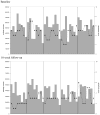Effects of a tailored activity pacing intervention on pain and fatigue for adults with osteoarthritis
- PMID: 21218677
- PMCID: PMC3655423
- DOI: 10.5014/ajot.2010.09198
Effects of a tailored activity pacing intervention on pain and fatigue for adults with osteoarthritis
Abstract
Objective: We examined whether tailored activity pacing intervention was more effective at reducing pain and fatigue than general activity pacing intervention.
Method: Adults with knee or hip osteoarthritis (N = 32) stratified by age and gender were randomized to receive either tailored or general pacing intervention. Participants wore an accelerometer for 5 days that measured physical activity and allowed for repeated symptom assessment. Physical activity and symptom data were used to tailor activity pacing instruction. Outcomes at 10-week follow-up were pain (Western Ontario and McMaster Universities Osteoarthritis Index) and fatigue (Brief Fatigue Inventory).
Results: Compared with general intervention, the tailored group had less fatigue interference (p = .02) and trended toward decreased fatigue severity (p = .09) at 10-wk follow-up. No group differences were found in pain reduction.
Conclusion: Tailoring instruction on the basis of recent symptoms and physical activity may be a more effective symptom management approach than general instruction given the positive effects on fatigue.
Figures
References
-
- Bellamy N, Buchanan WW, Goldsmith CH, Campbell J, Stitt LW. Validation study of WOMAC: A health status instrument for measuring clinically important patient relevant outcomes to antirheumatic drug therapy in patients with osteoarthritis of the hip or knee. Journal of Rheumatology. 1988;15:1833–1840. - PubMed
-
- Brown CA. Occupational therapists’ beliefs regarding treatment options for people with chronic pain. British Journal of Occupational Therapy. 2002;65(9):398–404.
-
- Birkholz M, Aylwin L, Harman RM. Activity pacing in chronic pain management: One aim, but which method? Part one: Introduction and literature review. British Journal of Occupational Therapy. 2004;67:447–452.
-
- Centers for Disease Control and Prevention. Prevalence of disabilities and associated health conditions among adults--United States, 1999. MMWR - Morbidity & Mortality Weekly Report. 2001;50(7):120–125. - PubMed



